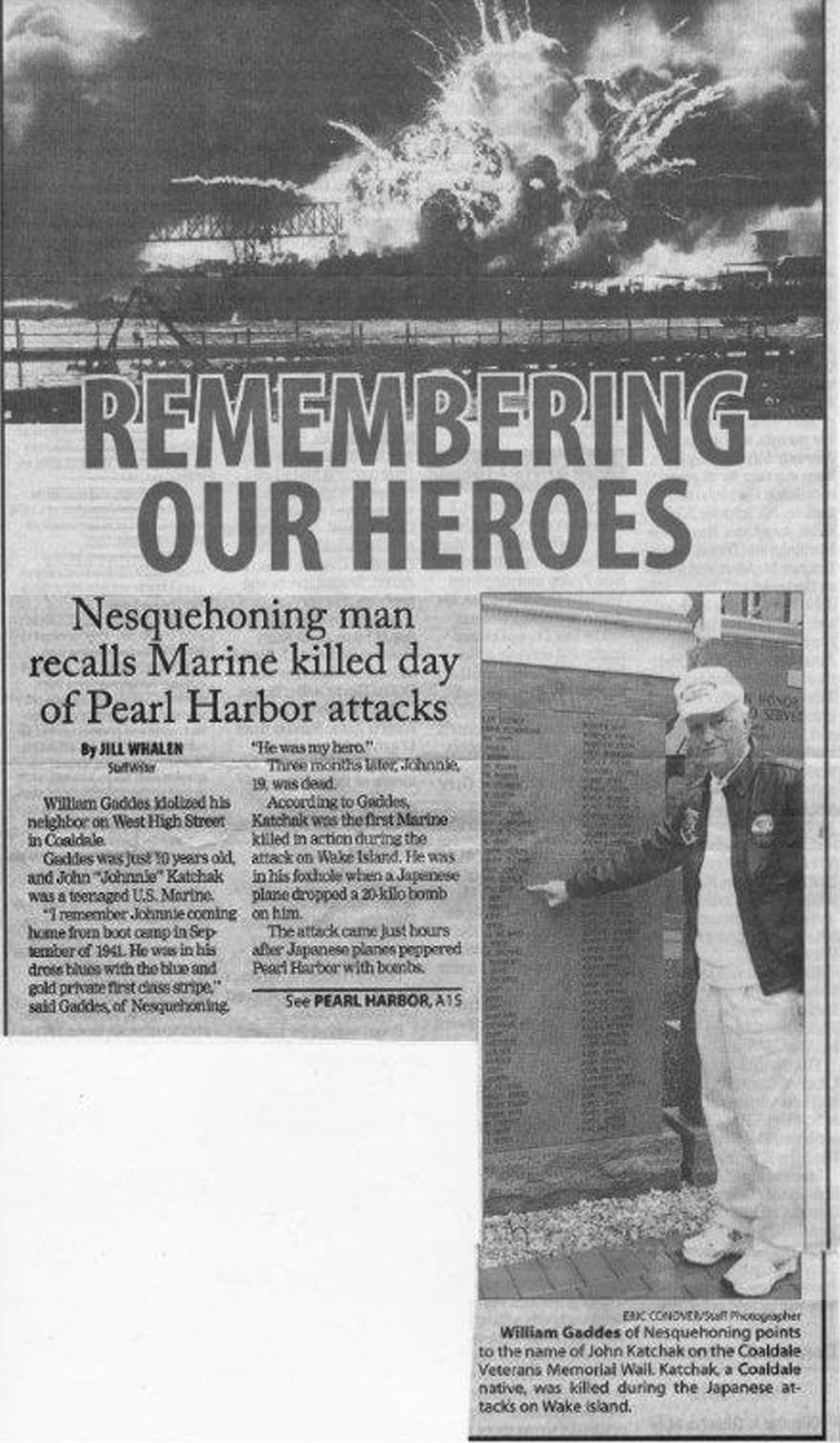On December 8, 1941, (our December 7), US Marine PFC Johnnie Katchak died when a small 20 kilo bomb, dropped from a Japanese plane, landed directly in his foxhole. This tragedy is mentioned in the book, "The Story of Wake Island", by US Marine major James Devereaux, Johnnie's commanding officer. PFC Katchak was among the very first US Marines killed in action during WW II. More than 35,000 marines would ultimately give the ultimate sacrifice for the freedoms we enjoy today.
William Gaddes, himself a combat veteran of the Korean War, spoke of his neighbor, Johnnie Katchak. "Johnnie lived directly across the street on West High Street in Coaldale. I remember Johnnie coming home from "boot camp"; in September of 1941. He was in his 'Dress Blues" with the blue and gold PFC stripe. I was ten years old at the time.
He was my hero. I hoped to join the Marine Corps. About three months later, he died on Wake Island. This very small atoll was considered a threat by Japan due to its proximity to the homeland. He would be followed by 53 additional heroes from Coaldale who were killed in action during WW II. I was rather frightened of the whole idea of Japan invading the United States. Two other men perished on December 7, 1941. Navy seaman George Stembrosky died at Pearl Harbor, and US Army PFC Wash Shaffron was KIA in the Philippines. Shortly thereafter two more Army soldiers from Coaldale died aboard separate Japanese "Hell Ships" that were sunk by US submarines. They both had survived the Bataan Death March. The grim toll was growing for the small hard coal town of Coaldale which was to provide 22.5 percent of its population to the military. This was twice the National average. The tragic death toll was four times the national average.
Johnnie's older brother George was already a sergeant in the Marine Corps. He survived the war with many combat decorations, including the Silver Star for heroism. Another hero who won two Navy crosses was US Marine sergeant George Lutchkus. As Gaddes researched the circumstances of the deaths of the 54 heroes, he was amazed at their incredibly unselfish and heroic actions.
PFC John Katchak's name is engraved upon Coaldale's WW II memorial Wall, with 1,359 others. It is followed by a star. Johnnies name is also included on a "Fallen Heroes Walk", located directly in front of the Memorial Wall. His mother, Mrs. Eva Wilkes Katchak, is included on the "Gold Star mother Walk of Honor" in the Women's Memorial Garden. Bill lovingly painted the gold stars on all 54 bricks included in that walk. Gaddes is shown indicating their names on the walks of honor. A bronze "Battlefield Cross", or "Soldier's Cross', sculpted by famous military sculptor Andrew Chernak, looks over both walks of honor. Bill has written a poem about the vigil of the "Soldier's Cross", as it keeps its vigil over the 54 names of those killed in action and their precious mothers. It goes as follows:
I AM MADE OF BRONZE; THE 'SOLDIER'S CROSS",
I SIGNIFY A TRAGIC LOSS.
AS I LOOK DOWN, I SEE A STAR,
THE NAME OF ONE WHO DIED ON SHORES AFAR.
I ALSO SEE SOME STARS OF GOLD,
FIFTY FOUR IN ALL; I AM TOLD.
ABOVE THE NAMES; MARY, HELEN, ANN,
LOVING ME; AS ONLY A MOTHER CAN.
THE PRECIOUS MOTHERS WHO DAILY PRAY,
PLEASE KEEP MY CHILD FROM HARM'S WAY.
AS NIGHT'S APPROACH WITH ITS DARK VEIL,
I'LL KEEP MY VIGIL WITHOUT FAIL.
AND WHEN THE SON'S NEW DAY SHALL RISE,
WE SHALL MEET AGAIN IN PARADISE.
WHERE PERFECT HEALTH AND BLISS SHALL REIGN,
AND WE SHALL SHARE OUR LOVE AGAIN.
Bill Gaddes
In May of 1952, Gaddes landed on Wake Island, almost 11 years after Johnnie gave the ultimate sacrifice. He walked around the island, and tried to imagine what it was like when Johnnie sat in his foxhole with his 1903 Springfield rifle, waiting for the Japanese to invade. There were rusting hulks of ships along the beach, and at base operations there was a light Japanese tank. Our Marines had shot down 32 Japanese aircraft, sunk a destroyer, two submarines, and several landing craft. They killed almost 1,000 Japanese invaders. The Japanese were so enraged at their losses, that they later executed 98 American civilians and Marines. The others would endure almost four years in Japanese prison camps, where American survival rates were only 50 percent.
It was a very moving experience to have visited Wake Island. Appendix A1 shows a photo taken by Bill Gaddes in May of 1952.
On this December 7, 2013, seventy two years after Pearl Harbor; our younger generation knows very little about World War II. It is the obligation of those who served, and their sons and daughters, to keep the memories of these sacrifices alive. Our Nation as we know it today, and our current freedoms and prosperity are the direct result of the sacrifices of the men and women who served during WW II; especially the 400,000 who gave the ultimate sacrifice. .
William Gaddes
25 November 2013
Shown above is a sunken Japanese troopship sunk by US marine gunfire during the Battle of Wake Island on December 8, 1941. Photo taken in May of 1952 by SSGT William Gaddes, USAF.



